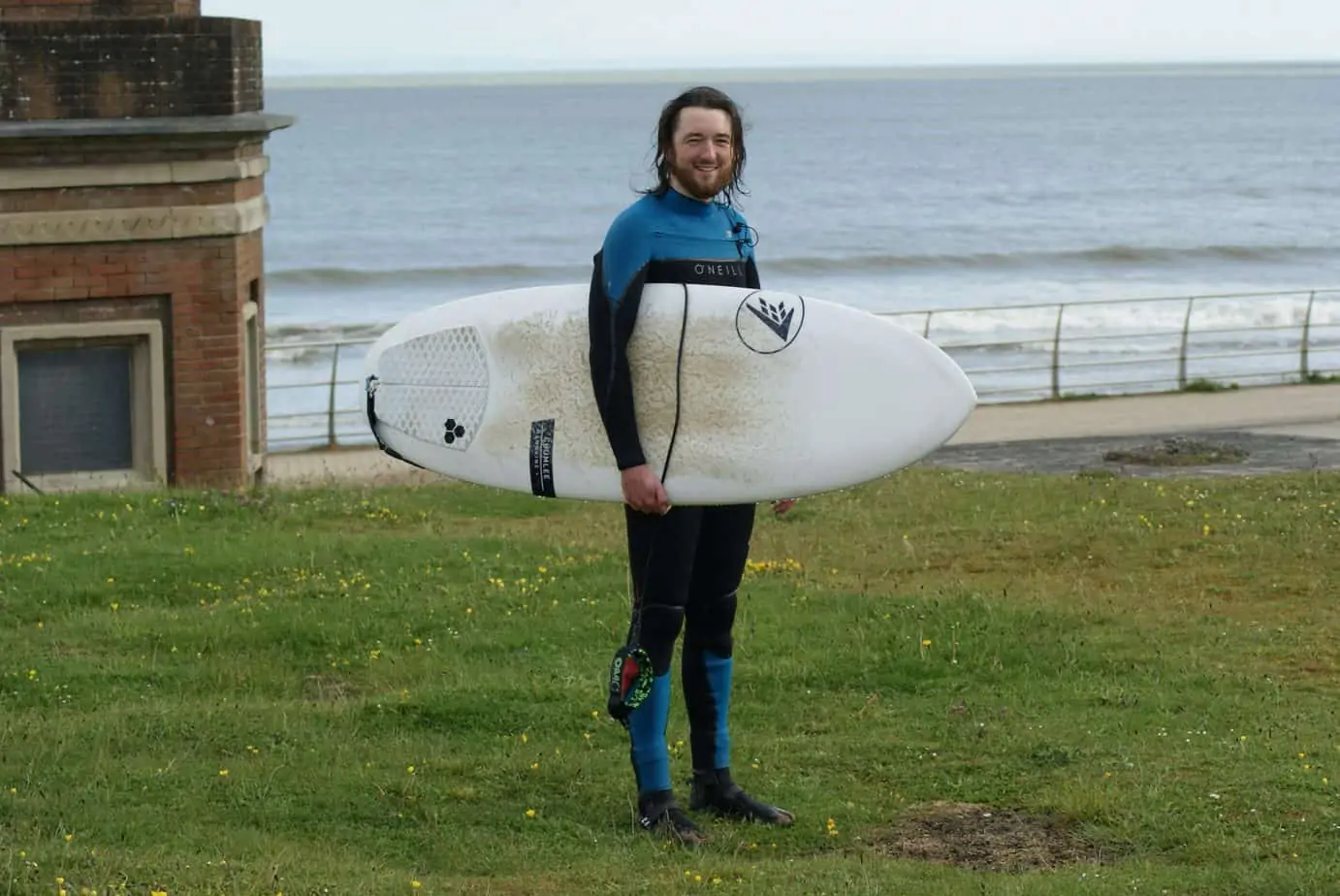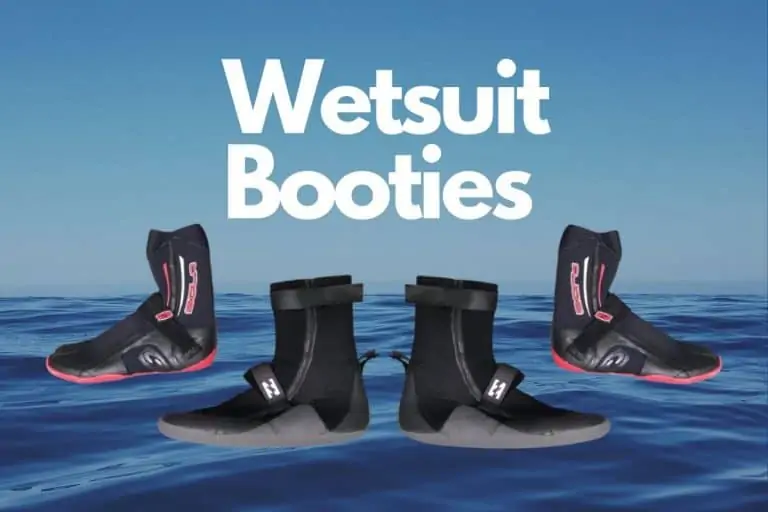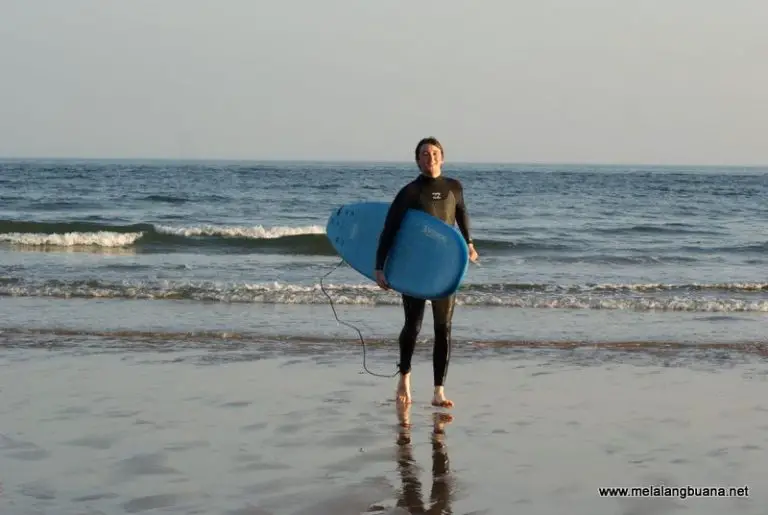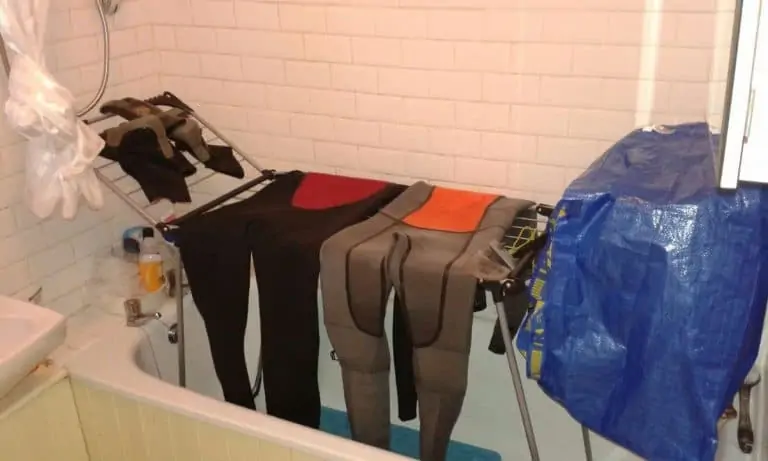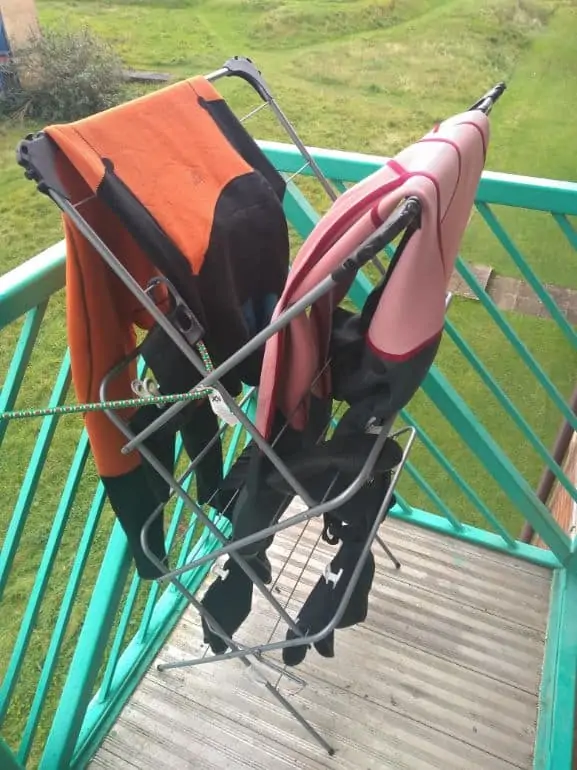Surf Wetsuit Buyer’s Guide
Buying your first wetsuit for surfing can be a daunting task with lots of different things to think about.
So with that in mind, I wanted to make this buyer’s guide for you in order to keep it really simple and give you everything you need to know. Also, to make sure you get the right wetsuit first time, and not end up with something that’s overpriced and not right for you.
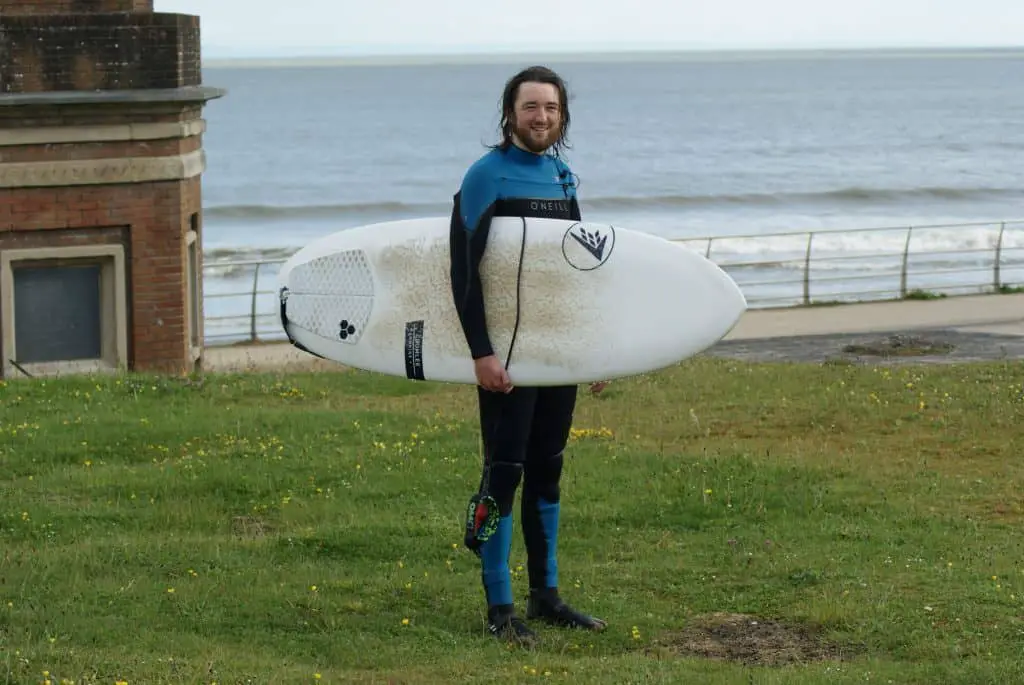
I’ll try to cover everything from a beginner’s perspective, make no assumptions, and leave no stone unturned to help you get that ideal wetsuit.
So with that said, let’s get to it.
How do I choose a wetsuit for surfing?
Get a 3/2mm full wetsuit for summer surfing with a back zip if you are just trying surfing or a chest zip if you are certain that you are going to surf often. If surfing in water over 67°F then you can get away with short sleeves or legs, or even boardshorts.
When buying, try on any surf wetsuit at a local store, ask the clerk for all the info you can get. Check the local water temperature when/where you plan to surf in and make sure the thickness matches. Don’t spend too much if you’re not going to surf that much.
Get a surf wetsuit to match your level of commitment: if you’re totally new to surfing and not sure how often you’ll go, or be able to go, factor that in.
For clarity, a full wetsuit means with long arms and legs, while a short or ‘shorty‘ wetsuit has short arms and legs (shorties are more suited to warmer summer water around 68-70°F). You can also get combinations of short arm/long leg wetsuits and vice versa.
If you are learning to surf in colder water (50-60°F), get a chest zip wetsuit with liquid taped seams by a good brand like O’Neill to make sure that the wetsuit is both warm and durable. More on this in the sections below.
I should also add that if you’re in a colder area, surfing in really cold water is a serious commitment. Check out the other articles I’ve got on that for surfing in freezing water and also my tips on how to stay warm in cold water when surfing!
Be sure to check out those articles now, if you need them.
How much should you spend on a surf wetsuit?
Spending 200 to 250 U.S. dollars will get you a good enough wetsuit to learn in and to see you through a few winters. Aim for a chest zip wetsuit by a good surf brand where possible.
Go a bit less if not, because the less you go, the less important it is, and also the warmer the water, the less you need to spend. But if you’re in a cold water area, do not cheap out. Do not go for the budget option.
Get yourself a good wetsuit because it will make your surfing more enjoyable. By this, I mean that you can go more often and spend more time in the surf, therefore, learning and progressing with your surfing that much faster.
As a side note, if you want to see how long it takes to learn to surf, check out my dedicated article on that now.
Premium Features on Surf Wetsuits
If you spend a little more, you can get a surf wetsuit with added ‘premium’ features that will make it last longer and keep you warmer for longer.
The most noticeable part of this is in the seams, specifically where more expensive wetsuits have what are called ‘liquid-taped seams’.
This sounds quite technical but is quite simple: the seams on the wetsuit are always stitched as standard, but the liquid taping goes over the stitching as an extra feature.
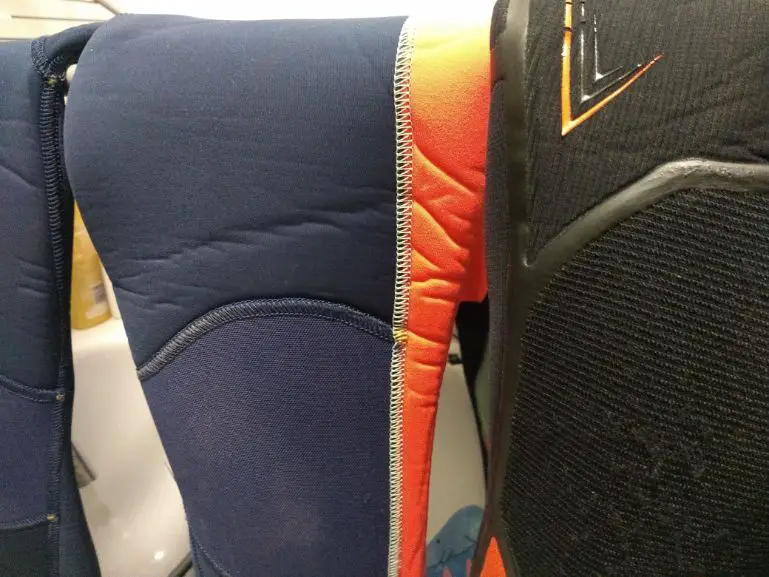
Notice the liquid taped seam around the knee pad on the black wetsuit and the standard stitching on the colorful one. This is a key difference between premium and standard wetsuits.
This makes the seams take in less water and also holds them together, reinforcing the original stitched seams, in turn making for a wetsuit with a longer lifespan. In this case, you really do get what you pay for.
What I’ve noticed is that the more expensive the wetsuit, the more of the seams have liquid taping on them (and there are a lot of seams on a wetsuit!)
I’ve also noticed liquid taping on the inside of the cuffs and ankles of my wetsuit to strengthen them since they become loose and the ankles can tear after time from constantly having a foot/heel pushed through them.
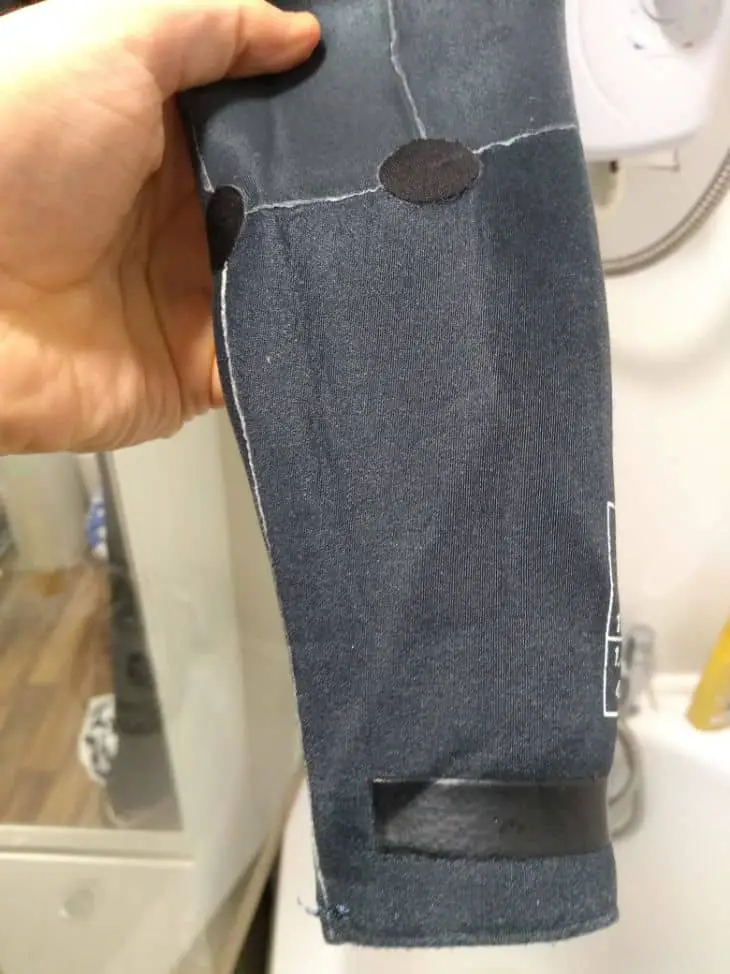
You will also see surf wetsuits with different thermal features, like a polypropylene thermal layer on the inside, for instance, in more expensive wetsuits. This fluffy material again adds warmth but also cost.
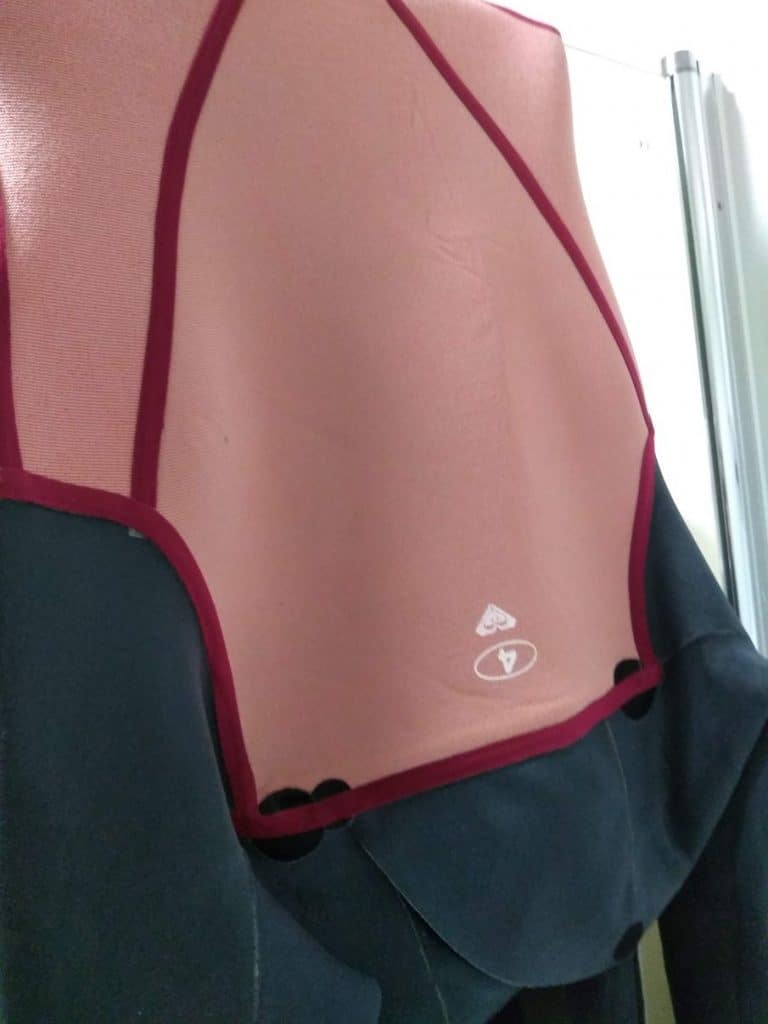
It really depends on your budget and how expensive you want to go with your surf wetsuit as there are so many variations, but we’ll look at this in more detail below.
What’s the best wetsuit for surfing?
A chest zip wetsuit that is a snug fit, made by one of the major brands, because it is a serious piece of hardware. Anything less will have restricted movement, be an uncomfortable fit, or just not be very warm.
So it really is a false economy. Spend the money on a good surf wetsuit and have a good surfing experience as a result.
You don’t need to get the most expensive one, but you do need to go at least in the middle to high price range to get a good one. So be sure you do that and don’t go too cheap.
Which wetsuit brand is best?
O’Neill or Xcel for cold water, with Patagonia and Vissla close behind. For warm water, the same plus Rip Curl and Body Glove. I do not recommend Billabong or Quiksilver.
I’ve tried Billabong wetsuits and I didn’t find it very good. Also, I’ve not heard many people say good things about them.
For me, Quiksilver is more of a fashion brand. I’ve never heard anyone say good things about them and I think they’re overpriced. Although it does have its roots as one of the pioneers in wetsuits, I don’t recommend them and wouldn’t suggest you buy one.
Surf Wetsuit Sizing
Getting the right size wetsuit is probably the most important part, because if it’s slightly too big or slightly too small, it really doesn’t function.
If you get a wet suit that’s big and baggy, perhaps long in the legs or just loose in the chest, it’s going to let in a lot of water, you’ll get really cold, really quickly. You’ll just have no fun in the surf because you’ll spend your whole time thinking about your wetsuit.
On the flip side, if it’s too tight, that can be downright dangerous, so you want to avoid that too. The main problem with sizing a wetsuit is when people buy them online and they do not try them on first.
My recommendation, therefore, is always to buy a wetsuit in a local store and in-person wherever possible. If you are not in a place near the surf where you can do this, then see if you can wait until you can go to the beach to do it.
Obviously you’re going to go surfing at some point if you’re buying a wetsuit, it’s probably better to wait. If you really want to buy one online, just make sure you read up and check the size guides on each wetsuit brand’s website, which is the next point.
The size guides of wetsuits are available from all the main brands and they are quite detailed. You need to be careful if you are in between sizes.
So let’s say I am six foot tall, and that is often an in-between size, between a medium tall wetsuit and a large. So if you’re not sure, I would hold off until you can buy one in-person.
However, if you’re clearly in the middle range for all of the sizings, and that includes things like chest, I think leg they’ve got, as well as a general overall size and weight guide, then you should be okay.
But if you’re on the boundaries of any of them, as is quite likely, I would still strongly recommend going back to the physical store and getting one there.
Again, if you really are compelled to buy a wetsuit online first time, make sure they’ve got good return policy. Wetsuits are quite heavy and big, so you don’t really want to be paying the postage if you have to return it.
That said, if you’ve got a known wetsuit brand that you’ve tried on before and you know the size fits, take a note of that. Go for a same size, different model, and you should be okay. This applies after you’ve bought your first wetsuit.
If you are happy with it, then you could stick with it and buy online. But if you’ve not used that brand or bought one from them before, then think carefully about doing that, and do the other options discussed above.
Wetsuit Fit
The main points to look for in the fit of a wetsuit are, firstly, how tight is it around the neck?
If it’s too tight, it’ll feel like it’s strangling you, and if it’s too loose, it’ll let in water. I mean, the same for all of it, but the neck is the first point you notice.
Also, you want to be able to move in it. So you want some movement around the shoulders, but again, you don’t want that baggy feeling. So you want to get it just right.
Remember that wetsuits, once wet, will stretch a little bit. So they do change that feeling from when they’re dry, the first time in the shop, but don’t expect them to change too much.
So go with the right feeling, ask the store clerk for their advice or opinion, and take it from there. It’s always a little bit of a leap of faith with a new wetsuit.
Even I’ve been surfing for over 20 years and I’m still always a little bit hesitant. But there is no other way, other than getting out in the surf, and for every one I’ve bought in-person, I’ve been fine so far.
What to do if my surf wetsuit legs are too long?
You have to fold them up around the knees or thighs. There is nothing you can do, because if you cut the legs, it will destroy the design of the wetsuit and void your warranty.
Best is to avoid this brand of wetsuit and get a different brand next time. Look for any tailored or custom wetsuit makers in your area that you can find, and go down that route if you don’t fit any of the standard sizes.
Which are the best surf wetsuit brands?
For me, there are a couple of key players that are clearly the best surf wetsuit brands, listed in order.
- O’Neill
- Xcel
- Patagonia
- Vissla
- Rip Curl
- Body Glove
Those would be my top choices for anyone buying a wetsuit because of a combination of factors.
O’Neill and Xcel are the best for cold water areas
They are from cold water areas, namely Santa Cruz in California, and so they’re designed with lots of R&D, years of hardcore cold water surfing in mind. They also make excellent summer wet suits, as well.
The only catch with O’Neill and Xcel is that they are a premium product because of the quality, but you get what you pay for.
Patagonia and Vissla
They are also very high quality wetsuits, slightly newer entrants into the market, particularly Vissla is much newer. They’ve also got more of the eco credentials and they make some very good hardware.
Patagonia has a very nice ethical focus. So if you’re looking for a surf wetsuit with the entire product lifecycle in mind, that kind of conscience behind the product, then Patagonia is an excellent choice as well.
Rip Curl
They have pedigree as a longstanding wetsuit pioneer in Australia, and around the world, of course, but originally from Australia. I’ve had a wetsuit by them that was really good in the past.
It didn’t last as long as I thought, but probably because I treated it badly. It was extremely comfortable and flexible, and I’ve heard lots of good things about Rip Curl wetsuits over the years.
Body Glove
They are a reputable surf brand. They’re a bit further down the list based on my experience and from others, they’re not quite as good as the others. They do have perhaps slightly lower prices as well. So they round out the top recommendations for surf wetsuit brands.
As I’ve said above, I don’t recommend Billabong or Quiksilver surf wetsuits to anyone, simply because of my own experience, the experience of friends and peers, and just never really hearing any glowing reviews about them.
So that would be my recommendation.
Surf Wetsuits for Cold Water
Temperature
Now, the first thing to look at is the temperature guide on the surf brand’s website. Yes, I said to go and buy one in a store so you can ask them in person or look at the label on the wetsuit, but also do your research online.
This is where the first question goes to you, what kind of temperatures will you be surfing in, in your local area? How low a temperature do you want to surf in?
I say this because it took me, starting to surf as a teenager, several years before I could afford the winter wetsuit because they are a lot more expensive, and before I actually had the desire to go out in the cold waters.
Wetsuits are graded in thickness for different temperatures. Generally speaking, you will have a 3/2 millimeter summer suit. That is three millimeters in the chest and central area, and two millimeters in the arms and legs.
This is a standard design. It is thicker around the middle to keep you warmer, slightly thinner on the limbs and extremities because you don’t need as much warmth and it allows for more flexibility and movement.
If you go up, another standard thickness of surf wetsuit is 4/3 millimeters. So again, four in the chest, three in the arms and legs. That will do year-round or, sorry, in the colder months in California, for instance, without any problem.
If you’re getting into even colder water, like the ones I have to surf in winter, for about six months of the year, then you need a 5/4 millimeter wetsuit. This is getting down to below 60 degrees Fahrenheit temperature water.
You can check the water temperature of your local surfing areas online. It is available from any of the main surf sites, like surfline.com or magicseaweed.com and see the range throughout the year.
Not one surf wetsuit will cover an entire year in an area with seasonal variation. So try to get one that suits as many months of the year as you want to go.
To that point, remember that you will probably need to buy a second wetsuit if the water in your area gets cold in winter, so you need to have that factored in as well.
Best option is to start in the warmer months and then see if you want to stick it out for the colder months. But gradually build up.
Don’t go and splurge, and buy three wetsuits and never use them. Get a summer suit first, and then see how you go, starting in those warmer months, and take it from there.
Should I get a surf wetsuit with a chest zip or back zip?
Go for a chest zip because they let in less water, keep you warmer, and are more comfortable, but are more expensive. This is, again, if you’re committed and you know you’re going to surf a lot, because of the extra price of them.
Chest zip wetsuits are also great if you’re going to be surfing in those colder areas. They let in less water due to their design.
The zip is on the front, obviously, the chest, but it’s also smaller. So there’s less of a weak spot than there is with a long back zip at the back, that goes down the length of your spine.
But if you’re just starting out and you want a more economical wetsuit, a back zip wetsuit is fine for warmer months of the year and just getting to grips.
How to care for a surf wetsuit?
Always leave it to dry on a wide or padded hanger, out of direct sunlight. Wash it in fresh water. Use light or baby shampoo every couple of months if you need to get rid of the smell.
Otherwise, never tumbled dry it, never treat it harshly, and just treat it gently, because a surf wetsuit is a sensitive piece of kit and doing many of those things will void the warranty.
Hanging up a surf wetsuit
I use a laundry rack to hang my wetsuit and my wife’s wetuit. We put this sometimes in the bath overnight, or outdoors in the shade. See my dedicated guide to the best wetsuit hangers here now, if you want more info on that.

What to wear under a surf wetsuit?
The best option is for a rash guard on your top and rash shorts on the bottom if you need it. Although many people are fine with going commando.
For women, wearing a bikini under a wetsuit is ideal because it makes changing in the car park that much easier and also avoids any rub in sensitive places. The same reason I recommend rash guards or rash layers for men, to avoid that rash possibility.
Although if you get a good wetsuit, you shouldn’t have a rash, as this is a thing of the past, since rashes were much more common when wetsuits were much cruder and more poorly designed than they are today.
Best Wetsuits for Surfing
So to round up, get a wetsuit that is a good fit, from a local store, made by O’Neill, Xcel, Patagonia, Vissla, Rip Curl, or Body Glove. Get a chest zip one if you can afford it.
Get one to suit the thickness for the majority of months of the year you want to surf, with the right water temperature in your local area. Make the most use of talking to local surfers and also the clerk in the surf store if you can go there in-person.
Only buy a surf wetsuit online if you’re absolutely sure and you know you can return it easily. Make sure that the size is a perfect fit for you, that you are not on the limits of any of the sizings in any of the areas.
With that, you will get the right surf wetsuit first time, and have a lot more fun, and progress your surfing that much faster. Good luck and happy surfing!
